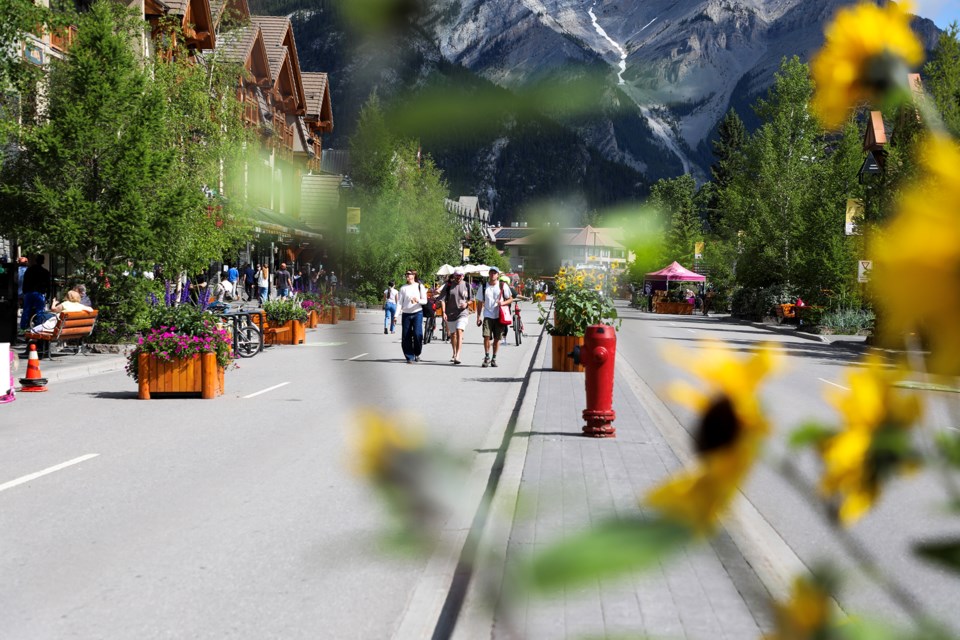BANFF – Advanced polls are closed ahead of the Aug. 12 voting day on the future of Banff’s controversial downtown pedestrian zone.
A total of 1,246 residents voted in advanced polls, including 491 voters in the third and final advance poll on Monday (July 29).
“The summer vote on a single topic is very different from a municipal election vote, so we are not making comparisons,” said Jason Darrah, director of communications for the Town of Banff.
A binding vote of electors will be held Aug. 12 on whether or not to have a pedestrian zone on Banff Avenue every summer.
Currently, the Town of Banff has had 119 requests for special ballots, but that is not necessarily indicative of an actual vote.
“We will not know until the evening of Aug. 12 how many have actually been returned and how many are valid votes,” Darrah said.
The exact number of eligible voters in Banff is not known; however, in the last municipal election in 2021, Alberta Municipal Affairs estimated eligible voters at 7,055, while the 2021 federal census for Statistics Canada reported Canadian citizens aged 18 and over at 4,450.
Council decided to go the route of a vote of the electorate after a petition declared valid under the rules of the Municipal Government Act collected more than 1,000 signatures in opposition.
Campaign funding
Banffites for a Comfortable Living Community is on the no-side of the vote and is the group of residents that distributed the valid petition.
The Friends of A Better Banff Ave. is a coalition of locals and businesses committed to keeping the pedestrian zone.
Both groups say they are taking third-party advertising rules seriously and committed to full transparency around funding. Following the vote of the electors, the groups have 120 days to file third party election advertising returns.
The Friends of A Better Banff Ave. say funding for the “yes” campaign has been used to develop strategy, campaign materials such as a website, posters, buttons, social media pages, and support for photo contests and two events to raise awareness of advance voting.
In addition, the group says local communication professionals, Shift Consulting, have been hired to help develop the campaign.
Allan Buckingham, a spokesperson for Friends of A Better Banff Ave., said funders include individuals and businesses such as Banff Hospitality Collective, Banff Lodging Co., Bike Banff, Discover Banff Tours, Tooloulou’s, and Rocky Mountain Soap Co.
Buckingham said the campaign is supported by a growing number of locals who believe “a better Banff Avenue prioritizes people over cars.”
“For the individuals who have asked to contribute to A Better Banff Ave., we will soon have a means to accept individual contributions and we will publish this information on our website,” Buckingham said.
Leslie Taylor, who heads up Banffites for a Comfortable Living Community, said 33 individual donors have contributed to the “no” campaign so far, noting those funds have strictly been directed towards advertising.
The lowest amount contributed is $50 and the highest is $3,000.
“We are talking personal donations in every case. I think this is very positive and an example of how grassroots-driven the no side is,” she said.
“I think that’s important because I would like people to think about what the motivations are of the supporters on the two sides.”
Taylor said the no side of the pedestrian zone vote is motivated by concerns about blocking the main artery around which the Banff community is designed, and pushing commercial traffic and visitor congestion into residential neighbourhoods.
“We are concerned about the increase in housing demand created by the increase in commercial activity and we are concerned about a potential conflict with Parks Canada over the commercial cap,” she said.
In voicing strong support for the pedestrian zone, Buckingham said there have been so many initiatives to address sustainable tourism over the past few years, from the transportation shift campaign to Bear Street refreshing to intercept parking to bike valet services.
“It’s about creating a more livable and enjoyable space for locals and for visitors; not just a town centre to move people through,” Buckingham said.
According to the group, it is clear more ways are needed to manage the growing popularity of Banff.
“Friends of a Better Banff Ave want better solutions for managing tourists that also benefit residents,” Buckingham said.
“That’s why there are so many residents – like me – volunteering for A Better Banff Ave. We see the pedestrian zone as part of a bigger vision related to connectivity and sustainability in our town.”
Taylor said sometimes a community-wide vote can be a problem if people are guessing what the future will look like based on a proposed program.
“In this case, people have had four summers and almost a fifth to experience what this situation is like, and so it’s unusual to have people voting on something that they’ve got so much experience with,” she said.
“I think it’s not only unusual, but it’s very positive because people are voting about something they know.”
According to Buckingham, there are concerns some residents are voting “no” to send a message about over-tourism to council, or voting in opposition because the pedestrian zone isn’t perfect as it stands today.
“Voting yes will tell council we want them to keep bringing solutions forward and that places where our community can gather and interact with one another are valuable and appreciated,” Buckingham said.
Banff’s pedestrian zone started in 2020 in response to COVID-19 pandemic social distancing requirements. Having outdoor seating allowed restaurants to stay in business while observing COVID protocols.
Town council continued this emergency measure in 2021, then extended it for two more summers to help with economic recovery in the tourist town. In January 2024, council voted to make this an annual practice, from Victoria Day long weekend to Thanksgiving every year.




